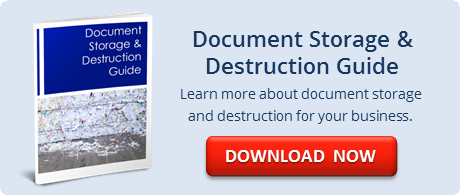3 Records Management Gaps That Could Harm Your Business
Wed, Oct 05, 2016
By: Jim Beran

Keeping business operations streamlined and running smoothly is a key goal for many business owners. After all, as your business grows, so too do clients, responsibilities, and business documents.
Business documents may include the paper documents you house on-site, or the electronic records you keep for each new customer. Managing records is a necessary aspect of many businesses, but keeping them organized and secure over time can present an unforeseen challenge for many business owners and administrative professionals.
In fact, there are a few gaps in records management plans that can prove harmful to your business if overlooked. Here are three gaps to avoid in order to maintain an airtight records management plan:
1. The gap between record creation and initial storage.
In an ideal world, when you first begin keeping records in your company, you’ll set a strong precedent for how you’ll store records in the future. Of course, that’s not always the case. Sometimes, businesses start out with a filing system that is antiquated or unsustainable, like stuffing papers into a metal filing drawer with little or no organizational focus. This type of storage mistake results in a drawer that is likely overcrowded, difficult to navigate, and lacks real security from fire, theft, or other damage or loss.
Close the gap by reflecting on how you plan to store your important documents from the get-go. Think about how often new paper documents come in, how they should be filed, and how long you’ll need to keep them. Consider whether physical document storage solutions will be best, or if you’d prefer to convert information to digital records with document scanning services.
Of course, you may already be past the point of initial document creation, in which case you may be dealing with another type of gap in records management.
2. The gap between record storage and ongoing retention.
This references the time between initial records storage and managing ongoing records retention. For instance, a company would ideally retain its records in a secure, organized way for the appropriate amount of time. This is all about knowing which documents you have on file, where they are, and how to easily retrieve them.
Potential problems can arise with storage and security, however. Companies may keep a record too long, or destroy it too soon. Depending on the type of document, both of these can result in noncompliance risks. This is especially true when documents are moved or stored incorrectly or by untrained staff, which can result in documents being misplaced or even stolen. These types of compromises can quickly harm a company’s reputation and trustworthiness.
Close the gap by working with trained and certified records specialists, and by maintaining an up-to-date retention schedule.
3. The gap between retention and destruction.
Businesses can also get caught in the gap between document storage and document or data destruction. This happens when a company fails to properly destroy its records at the right time. For example, in-house destruction with a desktop residential shredder has a tendency to open a business to risks such as identity theft, equipment failure, or improper use of resources, like relying on untrained staff to handle shredding sensitive documents.
Close the gap by considering a document destruction company with the industry grade resources to securely receive, move, and shred your company’s sensitive documents.
When it comes to records management, be sure not to fall into one of these potential gaps which could harm your business going forward. Instead, consider working with a certified records management company to keep your business on-track and compliant for your business’s future growth. Mind the gap. Learn more about streamlining your records management strategy in our guide below.
